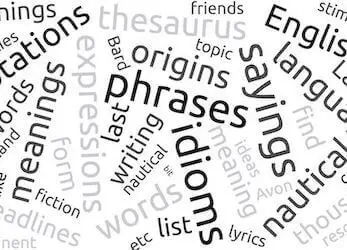In a position where advance and retreat are both impossible; in a fix.
In a cleft stick
What's the meaning of the phrase 'In a cleft stick'?
What's the origin of the phrase 'In a cleft stick'?
When we cleave something we split it into two pieces. It is then said to be ‘cleft’ or ‘cloven’. These archaic-sounding words aren’t commonly used alone these days and only persist in phrases like ‘cleft-palate’, ‘cloven-hoofed’ and ‘in a cleft stick’. Cleft sticks are those which are split at one end, that is, forked sticks and they were used as simple tools for carrying small items such as bundles of paper or candles. Jonathan Swift makes a reference to such in his ‘Directions to Servants‘ in Works, circa 1745:
“You may conveniently stick your candle in a bottle, or with a lump of butter against the wainscot, in a powder-horn, or in an old shoe, or in a cleft stick.”
Swift’s use, although hardly serious, is a literal one and doesn’t suggest the figurative use, which is first recorded in the correspondence in William Cowper’s Works, 1782:
“We are squeezed to death, between the two sides of that sort of alternative which is commonly called a cleft stick.”
‘In a cleft stick’ originated in the UK and its use elsewhere has always been limited. How did it come to mean ‘in a difficult situation, unable to move’? As is so often the case, there is more than one theory that purports to explain this. Theory One has it that cleft sticks were used to capture snakes, pinning them to the ground so that they were unable to move. Theory Two suggests that cleft pegs were used to punish over-talkative women, pinching their tongues so that they were unable to speak.
The first theory has the advantage of closely matching the meaning of the phrase – snakes certainly are sometimes caught and made immobile using split sticks. Also, the first citation of the use of a cleft stick to catch a snake pre-dates references in other contexts. That comes in the Review of the Works of the Royal Society of London, 1751, in which Captain Silas Taylor described ‘A Way to Kill Rattlesnakes‘:
Procure a cleft Stick, and put into the Notch of it, a Quantity of the bruised Leaves of wild Pennyroyal; direct the End of the Stick towards the Serpent’s Nose; as he avoids it, still pursue him with it; and in half an Hour’s Time he will be killed by the mere Scent of the Herb.
Snakes of any sort are a rarity in England – like most UK residents, I’ve never seen one in the wild. The English antiquary Taylor never travelled to America and would have needed a very long stick to kill a rattlesnake. In any case his rather roundabout herbal method of dispatching them isn’t quite the evidence we are looking for. On to Theory Two.
In 16th century England, women who were considered to be scolds, that is, users of abusive or ribald language, especially against their husbands, were in danger of being punished in a fearsome apparatus called a ‘branks’ – also known as a ‘scold’s bridle’ or ‘gossip’s bridle’. The device was an iron cage with a tongue that projected into the mouth of the victim to prevent speech.
A branks might look like a prop from a Ye Olde Englande B-feature, but they were widely used punishments throughout the Middle Ages. In 1890, when William Andrews published Old-time Punishments, Walton-on-Thames Parish Church had such a device on display. It was dated 1632 and inscribed with this little couplet:
Chester presents Walton with a bridle
To curb women’s tongues that talk too idle.
The early English settlers to the USA didn’t take those punishment devices with them and other methods for chastising unruly women were used there. The Records of the Town of East-Hampton, 1639-1680, transcribed and published in 1883, record the use of the alternative ‘cleft stick’ method in the case of a woman described as “very ignorant, selfish and imperious”:
February 2, 1652. “It is ordered that Goody Edwards shal pay 3 Lb or have her tongue in a cleft sticke for the Contempt of a warent.” [She had asked for the magistrate’s warrant to be delivered to her house so that she could burn it.]
This derivation is no more convincing than the snake pinning theory. Cleft sticks were clearly used as punishment devices in the 17th century in the USA, but there’s no link between that and the phrase ‘in a cleft stick’, which doesn’t appear in print there until many years after Cowper’s 1782 citation.
It is more likely that ‘in a cleft stick’ never did refer to a specific item but to the general condition of immobility when stuck between a cleft stick’s jaws – not unlike the later US phrase ‘between a rock and a hard place’.
See also: ‘between the devil and the deep blue sea‘.
The history of “In a cleft stick” in printed materials
Trend of in a cleft stick in printed material over time
Browse more Phrases
About the Author

Phrases & Meanings
A-Z
A B C D E F G H I J K L M N O P Q R S T UV W XYZ
Categories
American Animals Australian Bible Body Colour Conflict Death Devil Dogs Emotions Euphemism Family Fashion Food French Horses ‘Jack’ Luck Money Military Music Names Nature Nautical Numbers Politics Religion Shakespeare Stupidity Entertainment Weather Women Work
How did we do?
Have you spotted something that needs updated on this page? We review all feedback we receive to ensure that we provide the most accurate and up to date information on phrases.
